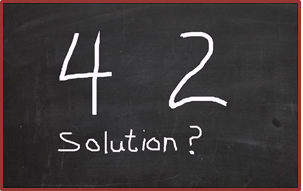If everyone functioned as they should and the world were cooperative, there probably would not be such a need for leadership. However, we will face problems and we will continue to be challenged regularly and problem-solving is a skill that leaders must have. Not only will the people who follow your leadership assume that you can guide them to effective solutions, you must also teach them the skill of problem-solving.
Many people rush through the diagnosis of a problem and begin acting hastily on assumptions. Not only does this fail to solve the problem, it also confuses others.
For more than 20 years Professor Edwin R. Keedy of the University of Pennsylvania Law School used to start his first class by writing two numbers on the blackboard 4 2.
University of Pennsylvania Law School used to start his first class by writing two numbers on the blackboard 4 2.
Then he would turn to the class and ask, “What’s the solution?”
One student would call out, “Six.” Another would say “Two.” Then several would shout out “Eight!”
But professor Keedy would shake his head in the negative. Then Keedy would point out their collective error. “All of you failed to ask the key question: What is the problem? Gentlemen, unless you know what the problem is, you cannot possibly find the answer.”
This teacher knew that, very often, too much time is spent trying to solve the wrong problem — like polishing brass on a sinking ship.
…unless you know what the problem is, you cannot possibly find the answer.
The first step in solving a problem is assessing the environment to understand what the real problem is. Too many times we hastily begin throwing “solutions” at things that are not the real problem.